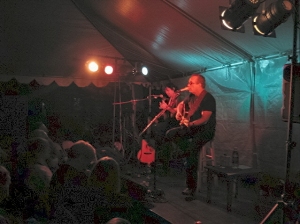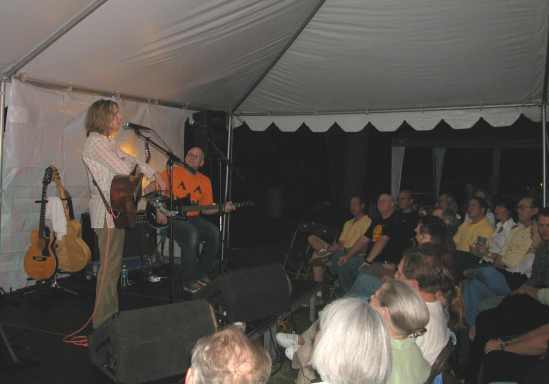It was the nightmare I’d feared for over a decade of hosting 60 house concerts: a rogue storm, threatening almost from the time Tara Nevins and Carol Elizabeth Jones took the stage, finally unleashed a torrent about an hour into the show.
Oh, it had rained before on nights I’d hosted shows at my series, North Shore Point House Concerts, but we always either had rented a tent or put the performers in the spacious wood garage. Hours earlier, my sound man and I, coddled by the clear forecast, had decided to set up outside under blue skies.
By the time the sheet of water descended, we’d covered the stage with one canopy and the sound board with another. People raced to shelter onstage, in the garage, and in the house. “We should go inside and just play acoustic,” Tara said, huddling onstage as people retrieved garbage bags to cover the instruments.
Fans with umbrellas and garbage bags ferried others inside during the deluge. There was food. There was drink. I shared bottles of Woodford Reserve and Knob Creek that I’d stashed away for the after-show. The air conditioning couldn’t keep pace; makeshift fans were fashioned.
Tara and Carol Elizabeth fixed themselves a fresh drink and sat in front of the living room fireplace. Furniture was pushed to the walls and people crowded in, many settling on the floor at their feet, a new fashioned bluegrass sit-in. Others crammed the entryway and the nearby dining room, some talking, others jockeying for a spot closer.
Tara and Carol Elizabeth played, and played, and then, when they wanted to finish, the crowd begged for one more, an old fiddle tune. A couple who attends nearly every show sat cross-legged right in front, fanning them as the music got hotter and hotter. A Donna the Buffalo fan, at his first North Shore Point show, swayed against the rear wall, occasionally singing along, encouraged by the Woodford Reserve and the moment. A daughter, up from Durham with her father, mouthed the lyrics to every song (Here is a link to their review of the evening).
They played everything they knew, outlasting the storm. With every song, every laugh or bit of applause, every shared nod, the evening became symbolic of the magic that’s happened time and again on these nights.
House concerts are many things. They’re about exploration, the thrill of discovery, of finding a new voice worth hearing. They’re about intimacy, a chance to break down the barrier between artist and audience. They’re often the only chance to get a coveted songwriter to play in this town (or many other towns, apparently; we’ve had fans travel from Nashville, Durham, D.C. and other far-flung locales for shows).
They’re about becoming a part of a community, meeting people with a shared interest in music — and maybe beer and wine and conversation. No doubt, dozens of those connections have been made at my house over the past decade. They’re about people like Bill, Mary, Mike, Wendy, Marc, Lou, Minnie, Gail, Sid, Ron, Gayle, Pat, Kelly, Russ, Barry, Charlie, Lisa, Ray, Sound Man Jim, and others who attend show after show, probably almost as much for the community as the music.
To me, house concerts, at least, my house concerts, ultimately are about these shared moments, moments created by the performer, but enabled by the setting and the community.
In the early days, artists and particularly their agents had to be convinced to book a house concert. Because of our attendance — we’ve had up 205 people at a show although a usual crowd is 80 to 100 — I’ve been able to make guarantees that made them easier to convince. Now, there are hundreds of house concert series, large and small, regularly and irregularly scheduled, across the country. They’re a part of the business plan for songwriters new and old. For every show we host, I could book five more.
At our series, all the donations at the door go to the artist. We front the money for sound, lights, chairs, when necessary, and a small stage when necessary. We do shows in three formats, outside, inside our spacious old garage, and in our living room, depending on the season and the demand for seats. Only a couple of times has the door failed to mee t my guarantees and the one time the shortfall was serious happened to be the night a couple of regulars decided (not knowing) that they’d make a huge donation to help cover our costs. So, yes, each show is a nervy game of “will I cover the guarantee?,” but as host it’s my job to get the artists a decent payday.
t my guarantees and the one time the shortfall was serious happened to be the night a couple of regulars decided (not knowing) that they’d make a huge donation to help cover our costs. So, yes, each show is a nervy game of “will I cover the guarantee?,” but as host it’s my job to get the artists a decent payday.
The reward, of course, is being the maestro of those magic moments, so many over roughly 60 shows. We had a successful free trial run with Michael Lille, a superb songwriter native to Nofolk. The first show we booked asking for a donation came six months later and featured Dave Carter and Tracy Grammer, a duo I’d heard on NPR. True to the shows that would follow, the informal setting encouraged them to try a song so new that Tracy read the lyrics from a notebook page. What I called the “dark womb” song appeared years later after Dave’s tragically early death on Tracy’s solo album as “Mother, I Climbed,” a haunting meditation on faith.
Indulge me looking back over a decade of the moments since that first show. Garland Jeffreys saying he didn’t need an introduction, then walking among the milling crowd, singing “Moonshine in the Cornfield” a cappella winding his way to the stage. Greg Trooper, master storyteller, mesmerizing on a chilly October night with a tale about a guy in a bar in Oklahoma, who during the break, told him he sounded just like one of his favorite songwriters, Greg Trooper.

Jeff Black bringing men to tears closing his first set with “Sunday Best” and “Gold Heart Locket. ” Jim Lauderdale saying the house had a “great vibe,” writing a song between sound check and the show, and then enduring an evening during which the electricity flickered during the first set until we realized the line into the house was literally burning out and ran extension cords to the side with good juice. Eliza Gilkyson‘s delight at returning — and then returning again. Kim Richey enchanted by her first house concert such that she sang until her voice surrendered (and then enchanted my children the next morning). She wasn’t the only first-timer. Garland Jeffreys, Dave Alvin, Steve Forbert, Marshall Crenshaw, Tom Russell, Tara Nevins, and others were house concert virgins who left converts.
There was Jason Ringenberg swinging his guitar and narrowly missing decapitating a front row fan and stomping the hardwood so hard with his boot heel that people checked for dents during halftime. Jimmy LaFave and band (a rare band show) coming into the garage on a threatening night and openly wondering if it could hold 90 people (including some outside space) and whether it was a good idea, then blowing the roof off during a summer shower and raving about the vibe and the community after the show. Caitlin Cary and Thad Cockrell and band hitting on all cylinders on a raucous and sweltering night. Don Dixon and Marti Jones, together again, leading the audience singing “Praying Mantis” as a round. Sarah Lee Guthrie and Johnny Irion’s very young daughter singing on stage for the first time. Sam Baker showing up with John Fullbright and Natalia Zukerman, two artists I didn’t know well, and deciding it would be cool to sit in the round with Kevin Welch and play songs all night, which the four of them made memorable. Amy Rigby making some of the men in attendance noticeably uncomfortable with songs like “Balls,” “Cynically Yours,” and “Beer and Kisses.”
The guys in Jimmy LaFave’s band lingered after the show to talk with fans. “You’ve got a special thing going on here,” one veteran of the road said. We hear that a lot, and, like hearing a regular has discovered a new favorite artist, it never gets old.
There are the before show dinners, at their best a respite for good food and conversation (at their worst, when musicians are late, a rushed feast as fans file in). Peter Case remembered the seared salmon with champagne vinegar potato sauce and requested it the next time. Mary Gauthier, once a chef, offered a bow to the honey gingered pork tenderloin. Eliza Gilkyson gobbled up the black bean and rice salad. Madison Violet squirreled away the leftovers for the long, after-show road trip to Toronto.
After the show, there’s often bourbon and BS. Welch, Baker, and Fullbright sipping bourbon and discussing an artist’s responsibility to his audience. David Olney debating racism in “To Kill A Mockingbird,” firing bourbon-laced ice at his antagonist. Trooper telling tales about Dan Penn, finishing songs for Aretha by writing in a studio closet. Martin Stephenson and his dobro player sitting out back, joining with a few regulars with guitar to play until 3 a.m. 
Performers often suggest artists to book. Welch and Richey recommended David Olney, a songwriter I didn’t know Months later at the show, a regular sitting in the back stopped me to whisper: “This guy is **&^* incredible. Where did you find him?”
Those moments are why I’m still excited before every show, why I’ve already booked shows into 2012 with artists like Steve Forbert, Garland Jeffreys, Kim Richey who’ve been here before, and artists new to North Shore like Nora Jane Struthers, Danny Schmidt and Carrie Elkin, Peter Cooper and Eric Brace and the legendary folk/blues master, Eric Andersen.
So I’m pouring two fingers of Knob Creek and raising a toast, not to the past, but to the future and another decade of magic moments.
